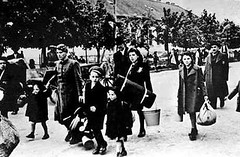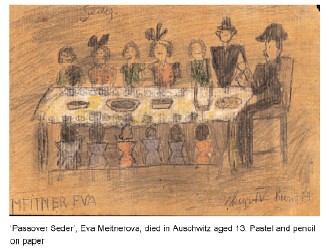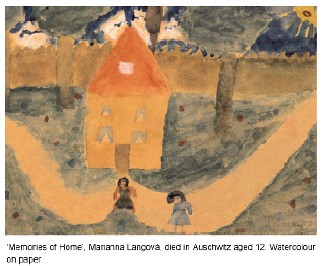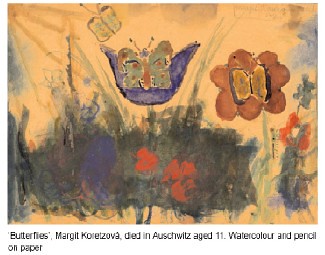
At the end of November 1941, Jews were transported to the newly established concentration camp at Theresienstadt (also called Terezin), 60 km north-west of Prague, where the Nazis aimed to establish a "model ghetto" as propaganda against international opinion. In reality, Terezin was a way station and most of its prisoners were later transported to Auschwitz.

To give the children at Terezin as normal a life as possible while they were in the camp, the Jewish leaders established a school of sorts, taught by the talented writers, scientists, artists and musicians imprisoned there.
Friedl Dicker-Brandeis, a Bauhaus-trained Viennese painter taught art lessons. She enabled the children to describe their pain and sadness, but she also helped them to transcend them. There are sad pictures, but there are also colorful flowers, butterflies, rainbows, and pictures of life at home before Terezin.
In autumn 1944 Dicker-Brandeis was deported to Auschwitz, leaving behind two suitcases containing more than 4,000 works done by the children, now preserved by the Jewish Museum in Prague.

The Red Cross was allowed to visit Terezin once. The village of Terezin was fixed up for the visit. One young mother remembers seeing the bakery window and shelves suddenly filled with baked goods the inmates had never seen before. Even the candy shop window was filled with bon bons creating an illusion she would never forget.
The Red Cross reported that while war time conditions made all life difficult, life at Terezin was acceptable. The Red Cross concluded that the Jews were being treated all right.
In the town of Terezin, the population had normally been around 5,000 people before the war. At the height of the war, the ghetto/concentration camp Terezin held over 55,000 Jews. Starvation and disease were rampant. Thousands died and their bodies were cremated at the small crematorium with four gas ovens. This was not a death camp, by the usual definition. There is no way to compare Terezin to Auschwitz-Birkenau or Treblinka or any of the other death camps where hundreds of thousands were murdered each year.
Terezin was liberated by the Russian army on May 10, 1945. Of the more than 140,000 people who had entered Terezin, only 23,000 survived. Of the 15,000 children who passed through Terezin, only 132 survived.
Pavel Friedman was born on January 7, 1921, in Prague and deported to Terezin on April 26, 1942. He died in Auschwitz on September 29, 1944. He wrote the poem The Butterfly while in Terezin.

The Butterfly
The last, the very last,
So richly, brightly, dazzlingly yellow.
Perhaps if the sun's tears would sing against a white stone...
Such, such a yellow
Is carried lightly way up high
It went away
I' m sure because it wished to
kiss the world goodbye.
For seven weeks I've lived in here,
Penned up inside this ghetto
but I have found my people here
The dandelions call to me
And the white chestnut candles in the court.
Only I never saw another butterfly.
That butterfly was the last one,
Butterflies don't live in here,
In the ghetto.

 The Butterfly
The Butterfly













































